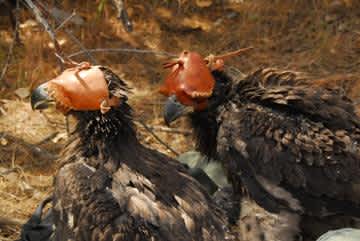Biologists Turn the Odds Around for a Pair of Nesting Bald Eagles in Arizona
OutdoorHub 08.15.12

After three consecutive years of failing to fledge its young bald eagles, an important Arizona nest site is back to adding to the growth of the state’s bald eagle population with two nestlings surviving to fledge on their own.
The nest became a challenge for Arizona Game and Fish Department bald eagle biologists when it began to fail at producing young eagles that made it to fledging age after many years of consecutive success.
“Returning this once productive bald eagle nest to its former successful status has been a priority for Game and Fish and its partners, but it required some perseverance and innovative approaches that had never been tried in Arizona,” says Kenneth Jacobson, bald eagle management coordinator for the Arizona Game and Fish Department.
The “Orme” bald eagle breeding area was discovered by biologists in 1987. From 2001 to 2008, the bald eagle pair that used the breeding area successfully fledged 15 young – a feat accomplished by only two other breeding areas in the state during the same period.
 In 2009, biologists were alerted to a problem when two of the nestlings jumped from the nest and ended up on the ground. Nestwatchers assigned to monitor the nest as part of the Bald Eagle Nestwatch Program noticed the birds on the ground, and Game and Fish biologists intervened. An examination showed the nestlings were covered in ticks that were slowly killing them.
In 2009, biologists were alerted to a problem when two of the nestlings jumped from the nest and ended up on the ground. Nestwatchers assigned to monitor the nest as part of the Bald Eagle Nestwatch Program noticed the birds on the ground, and Game and Fish biologists intervened. An examination showed the nestlings were covered in ticks that were slowly killing them.
During the identification banding of the nestlings the following year, biologists found the source of the ticks in one of the main support branches for the nest. They treated the three nestlings with a bird-safe insecticide in hopes of keeping the nestlings tick free until fledging. Unfortunately, treating the nestlings proved unsuccessful, so biologists attempted to spray the source of the ticks directly with insecticide and also sealed the infested area with hardening foam.
During routine banding of the young eagles in 2011, the nestlings were determined to be in good health, but it became apparent that neither approach worked when the nestlings again were found to have tick infestations several weeks later.
Game and Fish sought permits from the U.S. Fish and Wildlife Service and took extraordinary measures: they carefully removed the tick-infested nest after the nesting season, transported it offsite to be burned and began to build two manmade nests away from the old nest tree.
 Sticks, leaves and other natural debris from the desert floor were raised to the tree top bucket-by-bucket to create “starter nests.” Bald eagle nests average 3 feet wide by 5 feet long and can weigh up to 2,000 pounds. The adults add to the nest each year, making some of Arizona’s larger nests up to 15 feet tall and more than 7 feet wide.
Sticks, leaves and other natural debris from the desert floor were raised to the tree top bucket-by-bucket to create “starter nests.” Bald eagle nests average 3 feet wide by 5 feet long and can weigh up to 2,000 pounds. The adults add to the nest each year, making some of Arizona’s larger nests up to 15 feet tall and more than 7 feet wide.
The male and female eagles used one of the manmade nests this year and fledged the first two young to survive since 2008 when three young fledged. In total, eight bald eagle nestlings died as a result of tick infestation. One nestling was successfully rehabilitated in 2011 and fostered into a nest in another breeding area.
Arizona expects the bald eagle breeding season to conclude in the coming weeks when the last of the bald eagle nestlings in the northern parts of the state fledge. Fledging, a nestling’s first flight, is considered a significant milestone for a young bird.
Bald eagle conservation in Arizona is a partnership effort of the Southwest Bald Eagle Management Committee — a group of 25 government agencies, private organizations and Native American tribes.

